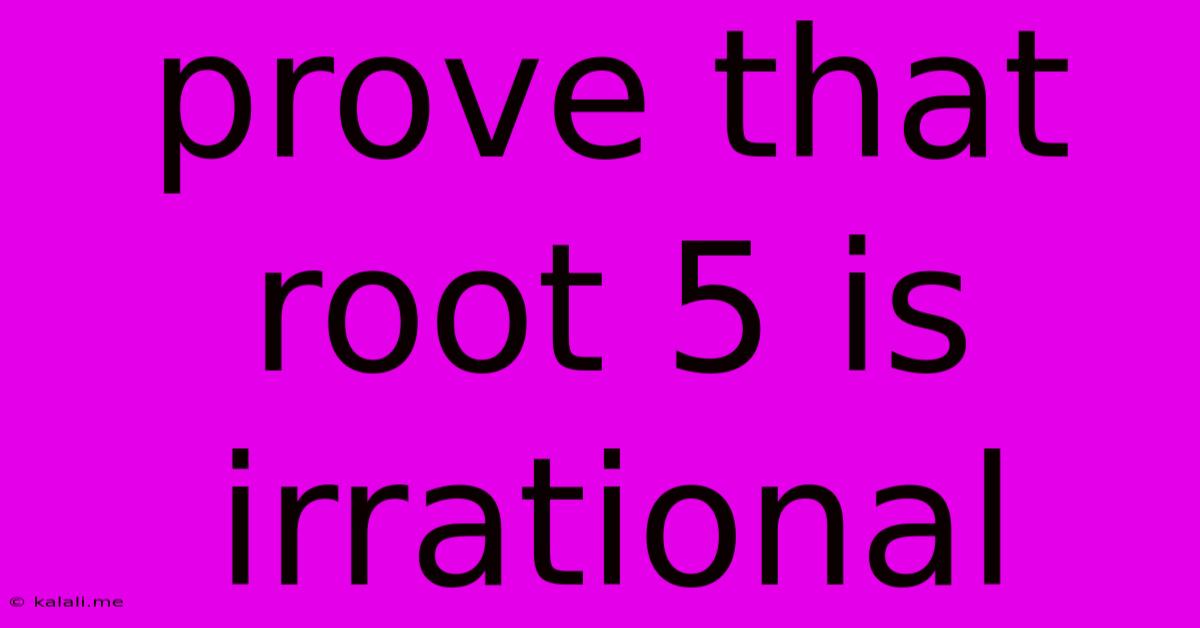Prove That Root 5 Is Irrational
Kalali
Jun 09, 2025 · 3 min read

Table of Contents
Proving √5 is Irrational: A Step-by-Step Guide
Meta Description: Learn how to definitively prove that the square root of 5 is an irrational number using the method of proof by contradiction. This guide provides a clear, step-by-step explanation, perfect for math students and enthusiasts.
The question of whether √5 is rational or irrational is a classic example in mathematics demonstrating the power of proof by contradiction. Understanding this proof not only solidifies your grasp of irrational numbers but also showcases a fundamental proof technique used throughout higher mathematics. This article will walk you through the process, breaking it down into easily digestible steps.
Understanding Rational and Irrational Numbers
Before diving into the proof, let's clarify the definitions:
- Rational numbers can be expressed as a fraction p/q, where p and q are integers, and q is not zero. Examples include 1/2, 3, and -4/7.
- Irrational numbers cannot be expressed as such a fraction. They have decimal representations that neither terminate nor repeat. Famous examples include π (pi) and e (Euler's number). We will prove that √5 belongs to this category.
Proof by Contradiction: The Strategy
We'll use a technique called proof by contradiction. This involves assuming the opposite of what we want to prove and showing that this assumption leads to a logical contradiction. If the assumption leads to a contradiction, then the assumption must be false, and the opposite (our original statement) must be true.
The Proof: Step-by-Step
-
Assumption: Let's assume, for the sake of contradiction, that √5 is rational. This means it can be expressed as a fraction p/q, where p and q are integers, q ≠ 0, and the fraction is in its simplest form (meaning p and q have no common factors other than 1).
-
Squaring both sides: If √5 = p/q, then squaring both sides gives us 5 = p²/q².
-
Rearranging the equation: Multiplying both sides by q² gives us 5q² = p². This equation tells us that p² is a multiple of 5.
-
Implication about p: If p² is a multiple of 5, then p itself must also be a multiple of 5. This is because the prime factorization of p² will contain at least two factors of 5 (since 5 is prime). Therefore, we can write p = 5k, where k is another integer.
-
Substituting and simplifying: Substitute p = 5k into the equation 5q² = p²: 5q² = (5k)² which simplifies to 5q² = 25k².
-
Solving for q²: Dividing both sides by 5, we get q² = 5k². This equation tells us that q² is also a multiple of 5.
-
Implication about q: Following the same logic as step 4, if q² is a multiple of 5, then q must also be a multiple of 5.
-
The Contradiction: We've now shown that both p and q are multiples of 5. This contradicts our initial assumption that the fraction p/q is in its simplest form (having no common factors).
-
Conclusion: Since our initial assumption leads to a contradiction, the assumption must be false. Therefore, √5 cannot be expressed as a fraction p/q, and it is irrational.
Further Exploration
This proof demonstrates a powerful method for proving irrationality. Similar techniques can be used to prove the irrationality of other numbers, like √2 or √3. The key lies in understanding the properties of prime numbers and their relationships within the equation. The elegance of this proof lies in its simplicity and its clear demonstration of logical reasoning.
Latest Posts
Latest Posts
-
You Will Always Have The Poor
Jun 09, 2025
-
What Didnt Get Caught In The Rain
Jun 09, 2025
-
Peel And Stick Vinyl Plank Flooring
Jun 09, 2025
-
What Is The Opposite Of Gray
Jun 09, 2025
-
How To Set Query Timeouts To Prevent Stuck Queries Rds
Jun 09, 2025
Related Post
Thank you for visiting our website which covers about Prove That Root 5 Is Irrational . We hope the information provided has been useful to you. Feel free to contact us if you have any questions or need further assistance. See you next time and don't miss to bookmark.